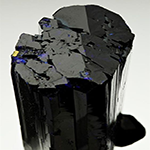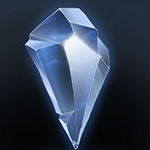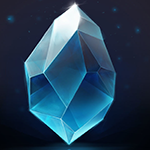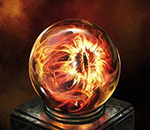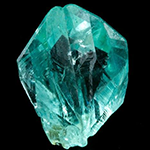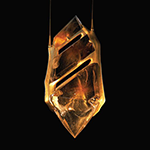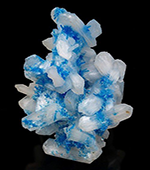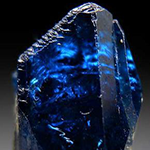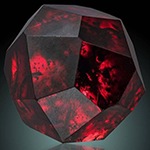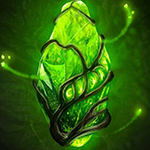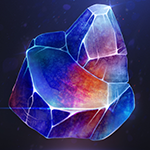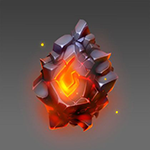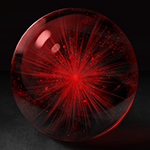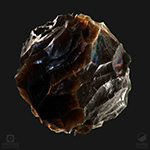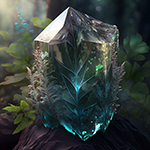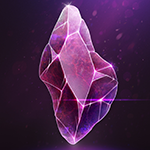Dragonshard
Dragonshards or aether gems, are the result of raw aether leaking through the veil that exists between the mortal world and the Aetherium. These gemstones are capable of manifesting powers that are either subdued and largely harmless to devastating or miraculous. These crystals have been a staple in Ranseran society since the dawn of time. Their uses are as varied as their properties and are limited only to what the clever and skilled are capable of devising.
General Properties
While there are many dragonshard types to be found throughout the world, every dragonshard exhibits a few universal properties.
- The power within a dragonshard will recharge on their own unless completely depleted or destroyed.
- Wherever dragonshards manifest, the veil between the mortal world and the aetherium is thin. Take caution.
- The weaker a dragonshard is in purity, the less broad and potent its effect. The stronger a dragonshard is in purity, the more broad and potent its effects become.
Purity Scale
The purity scale for dragonshards is a measure of their aetheric potency. The higher a dragonshard rests on the purity scale, the more potent its effects and the more reliable it is when put to use in magical crafting. Dragonshards can be refined by a runesmith, scrivener or alchemist with the right knowledge and skills to do so.
Lesser- The lowest classification of dragonshard purity. Capable only of rendering its inherent effects upon the world and only very minor at best. Typically the grade of shard used in the creation of Caster Shells
Minor- A very common and abundant classification of dragonshard. These crystals are potent enough in their aetheric potential to be able to sustain most Novice level enchantments when put to magical crafting.
Average - The benchmark scale of dragonshard to which all others are compared to in terms of purity. These crystals are potent enough in their aetheric potential to be able to sustain most Apprentice level enchantments when put to magical crafting.
Greater- Largely uncommon, these crystals are strong enough to sustain most Journeyman level enchantments when put to magical crafting. Typically, these types of crystals also have inherently blended properties.
Superior- Rare and typically costing a significant amount of coin if ever available for sale, superior dragonshards are most commonly employed in very complex magical work. Capable of housing Expert level enchantments, they are greatly sought after by high level magical craftsmen and mages.
Grand- Very rare. Grand dragonshards are capable of being employed in Master level magical crafting. They are almost never available on open markets as their price would be exponentially high.
Supreme- Exceptionally rare. Supreme quality dragonshards are the pinnacle of what most who dabble in their trade are aware of, hence the title. Capable of being employed to such astounding levels of magical crafting or use that the limits are truly only what the crafter can imagine.
Commonality
Dragonshards or Aether Gems, are common enough that the general populace likely see a use for a variety of them in their everyday lives. No matter what region of the world an individual lives in, the odds that they have NOT used or encountered a dragonshard of some sort in the early days of their lives is unlikely. No matter the turmoil of the world or whatever disaster strikes, the most stable and well-known reliable thing in both common life and even in commerce is a dragonshard. However, dragonshards vary by commonality in terms of which ones will be encountered or are even available in various areas of the world. That commonality determines the overall worth of the aether gem when it comes to trade.
Very Common - There is a surplus of this particular dragonshard. It is a passing, everyday thing. So much so that Greater scale versions of the dragonshard exist in a relative abundance where aether gems are concerned. As a result, the trading of such gems is seen as standard in terms of economic practice.
Common - There is a surplus of this particular dragonshard. Most merchants who trade in such things encounter them most everywhere they go, to the degree that even Greater scale version of them exist in relative abundance as far as dragonshards are concerned. As a result, the trading of such gems is seen as standard in terms of economic practice.
Uncommon - These are typically dragonshards that are environmentally specific such as a Frost Gem that requires very cold climates to manifest or will typically only do so during colder seasons. While still common enough to be seen on a regular basis, that regularity shifts depending on the locale. As a result, the trading of these gems is seen as more valuable in terms of economic practice.
Rare - These aether gems are not seen on a regular basis but the general populace of merchants who trade in dragonshards will have heard of them. They appear in both places around the world and in markets sporadically and are thus very valuable as a result. These dragonshard typically have properties that are unusual and peculiar such that they can produce exciting or exotic results.
Very Rare - Dragonshards of this variety are usually the height of what any person will encounter in their lives, if at all. Acquiring them is usually dangerous so while there may exist a place where they are commonly known to grow, obtaining them is exceedingly difficult. If such a dragonshard is available for sale, usually only the very wealthy can afford to buy them.
Exceptionally Rare - Unheard of in most place or it is a dragonshard that appears in very specific circumstances and in very low numbers. These dragonshards are often worth fortunes that most could not even dream of possessing and thus, possessing one could be a sign of prestige in some cultures.
Legendary - Typically a dragonshard of truly miraculous properties with occurrences in such rare circumstances that even most learned scholars who study the aether gems have no encountered them before. There is no price that can be placed upon these aether gems for even encountering one is so unlikely that most would not even believe it to begin with.
Mining Practices
The crystals occur naturally in many locations throughout the world. Some are mined as one would mine precious gemstones from the earth. Others must employ more detailed and careful methods of extraction or risk catastrophic results. Dragonshard miners work in very specifically trained teams of three or more at a time. At least one member of the team is trained in meditation and concentration techniques in order to tap into and bend the energies within the stones to their will. This allows for the other members of the team to safely extract the crystals without the risk of the power within them raging out of control. The more powerful the dragonshard, the more members of the team required to control its energies and for the most powerful, very special equipment must be employed to extract the stones.
Pickaxes- The most affordable pickaxes are treated with alchemical oils designed to absorb or nullify the energies released by dragonshards when struck. These oils must be periodically reapplied to the tools over time. On the most expensive end, they are runeforged tools specially created to the task of dragonshard mining.
Hammer and Chisel- As with pickaxes, the most affordable items on the market are treated with alchemical oils with the most expensive version being the product of runeforging.
Aether Net- The aether net is either treated with alchemical oils or is the product of runeforging. It is designed to be cast over a large area of dragonshards or one particularly powerful one. As the crystal(s) are being mined, the net captures the energies being released by them so as to avoid harm coming to the miners. These nets typically incorporate abjinurium.
Shard Beacon- Established in a perimeter around a particular mining area, these are either ordinary torches that employ alchemical oils or they are crystal nodes that employ Scrivening or are the product of Runeforging. Shard beacons ignite in a violet-blue fire when activated. These flames draw in latent aether released by the dragonshards whenever they are mined for their duration. This prevents the energies from extending past the area being actively mined in order to avoid catastrophe. Outsides of dragonshard mining practices, shard beacons see a variety of uses in magical crafting and containment.
Using a Dragonshard
Aether gems have had their properties and uses explored for thousands of years. As a result, the manner in which one can harness their power has been experimented with across the ages. The most common methods are as follows:
Willpower- The most rudimentary method of using a dragonshard. It is only recommended for the safest classifications of dragonshards and completely ill advised for more powerful or volatile shards. This is because using a dragonshard in this way requires that the user form a bridge between their aether and the aether of the dragonshard. The power of the crystal then flows through the user at the expense of their own aether. This expenditure is not so much lost in the use of the power, so much as the user must focus and concentrate in order to properly channel the powers at their disposal. Their aether is expended shielding their own body from the otherwise volatile energies of the dragonshard itself. In their raw or refined state, an individual need only focus on the dragonshard and open themselves up to the well of power inside them. Once this is achieved, a bridge between the individual's aether and the crystal's aether is established. It must be brought under control by the user through an exertion of willpower but once completed, they can then use the powers of the dragonshard at will. Mages have the easiest time doing this, as they focus on the manipulation of aether as easily as breathing. For non-mages meditation techniques are very helpful in forming the discipline necessary to bring a dragonshard under control.
Potion- Any dragonshard can be used as the chief ingredient or an auxiliary ingredient in an alchemical potion. How effective and potent the effects are depends on the shard used and the skill of the alchemist. The drawback of dragonshard potions is that they are only capable of manifesting portions of a dragonshard's power. While the aether needed to manifest this effect comes from the potion itself, it is singular and once expended, dissipates. Drinkers should be cautious. In order to manifest these effects, the potions open aether pathways inside the user. While one's own aether is not expended to fuel these powers, the aether to do so comes from the potion, the drinker's own aether is required to maintain those pathways and shield the body from the energies housed by the potion. In the case of healing potions, the user's aether is guided into motion to funnel the effects of the potion to the areas of the body in need of healing based on the intent of the healing concoction. This must be carefully considered however, healing potions, salves and tinctures, while being able to produce miraculous physical effects still strain the individual's aether. As a result, they are used sparingly in more critical patients until they can be brought to a safer condition through alternative methods.
Scrivening- The use of pictography to control, regulate and release the energies of a dragonshard is what is employed the most in the public market. Scriveners can employ pictography to program the dragonshard to release its magic in very specific ways based on triggers woven into their pictographs. This method of use has the benefit of drawing power solely from the dragonshard itself. However, the dragonshard will only release its magic in the specific ways that have been programmed into the pictograph and only through the triggers put in place by it, to the exclusion of all else. If the user does not implement the specific trigger, the power of the shard will remain dormant and again, the power will only be released in the way it has been programmed to function. It takes a very skilled Master Scrivener to create a pictograph that allows for nuance and flexibility.
Runeforging- Dragonshards are a staple in runesmithing and it is through runeforging that often times the highest potential for the crystals can be refined. Runeforged artifacts are capable of not only employing the abilities of the dragonshards in a nuanced or specific manner, they do so without the drawbacks of pulling on the user's own aether and will function so long as the artifact itself has the power to do so. The downside to runeforged artifacts is that they take a considerable amount of time, resources, and money to produce. Furthermore, a runesmith will rarely user higher level dragonshards for mundane tasks, preferring to devote them to more elaborate projects.
Elements Lodestones- Lodestones are manufactured by Elementalists and share many similarities to Dragonshards. More details can be found here. [Lodestone]
Compendium of Crystals
Abjinurium
Nickname: Magebane
Commonality: Rare to Very Rare
Properties: Magic cancellation, negation, aether nullification
Description: The terror for any wizard or magical creature, magebane possesses inherent negation powers that completely cancels out the occurrence of magic. Commonly employed by powerful nations to regulate the influence of magic users, if worked by one with the appropriate knowledge and skills, it can be used to completely sever a wizard from their powers in an extreme circumstance. Magebane is reputed to grow only in deep underwater caverns in the oceans and is thus precariously difficult to mine. It is identified as a solid black gem with pinpoints of near electric blue light that dot the stone.
Aerolyth
Nickname: Windstone
Commonality: Very Common to Common
Properties: Gusts, Breezes, Gale force winds, flight capability, levitation
Description: Aerolyth stones are most commonly found in high mountain regions or in open grasslands. Always accompanied by a gentle breeze or gale force winds depending on the level of purity of the stone, they have found many uses throughout Ransera’s history. They are described as a pale gemstone reminiscent of clear quartz crystal that is characterized by windy spirals that manifest on the surface of the stone. Windstones are most commonly used to serve as power sources for skyships.
Aetherite
Nickname: Aetherstone
Commonality: Very Common to Common
Properties: Raw aether, magic amplification, spell bolstering
Description: By and large the most common type of dragonshard crystal around, aetherstone is nothing more than raw aetherium that has crystallized. It is untapped potential, purposeless aether that is most commonly used as the foundation for introducing magic to potions, world magic crafting, or for use in the fueling of very advanced and potent spellwork. It is very common for mages to carry aetherstone on their person either as the raw gemstones or woven into accessories that they wear. It is characterized as a purple-blue gemstone that swirls with variations of violet or blue fire inside of it.
Aqualyth
Nickname: Waterstone
Commonality: Very Common to Common
Properties: Water manipulation, water purification or filtration, water creation
Description: Aqualyth typically grows near large bodies of water or in underground lakes or streams. These water sources are noticeably fresh and free of debris no matter the state of their surrounding area. Invaluable in desert areas due to their ability to produce drinkable water, it is not uncommon for travelers to carry one or two of these on their person. Waterstones are able to purify contaminated water of most non-magical contaminants. They are prized by alchemists and apothecaries for use in the creation of tonics, tinctures and salves due to the purity of the water produced by them. Waterstones are described as pale blue gems that appear to be filled with shifting water when moved.
Auralyth
Nickname: Aurastone, Aura Glass
Commonality: Very Common to Common
Properties: Aura Perception, Divination, Mood Influence
Description: One of the most commonly used dragonshards among wizards across the world, auralyth has the unique property of being able to bring an object’s aura into focus so that it can be studied. It is standard practice for most World Mages to have lenses crafted from auralyth in their laboratories. Auralyth stones can also be used to gently influence the mood of those within its proximity depending on the mood that is impressed upon it. This is achieved by attuning an area to he influence of the aura stone which then emanates that mood in the area, threading that emotion into the aura of those that enter its vicinity. Often times when people wander into a peaceful grove and are moved to feel a sense of tranquility it is because an aurastone could be influencing the area. The same can be said for an area that might fill one with dread. Its final property is a curious one that can only be found in the most powerful versions of the dragonshard, it has the ability to act as a divination stone, allowing the user to project their vision across great distances to observe an area from afar.
Daemithillium
Nickname: Demon Gem, Summoner’s Stone
Commonality: Very Rare to Exceptionally Rare
Properties: Spirit binding or entrapment, summoning empowerment
Description: Decidedly uncommon and highly coveted by practitioners of Summoning magic, daemithillium is a controversial gemstone that is banned in some areas of the world. Demon Gems have the power to absorb and bind Aldir and Endir to them, proportionate to the power of the stone itself. Minor and Lesser stones can only bind very weak and minor spirits and so forth. The individual holding the stone is then able to siphon the abilities of the bound spirit into themselves until the spirit inside is reduced to nothingness. This occurs in exchange for the user sacrificing their aether not only to tap into the stone, but to use the abilities of the spirit in question. Tapping into the stone more than a few times in one sitting leads very rapidly to dire consequences. As a result, these gemstones are more commonly applied in unique summoning rituals. Demon Gems are characterized as possessing a catseye pattern upon their surface and when rotated seem to shift with an almost fiery inner light.
Frostrylyth
Nickname: Ice Gem
Commonality: Common to Uncommon
Properties: Ice, frost, cryogenic properties, can conjure or influence blizzards, hail storms etc.
Description: Found only in the coldest regions of the world, ice gems are highly valued for their usefulness in storing perishable goods. The gemstone grows commonly enough but due to its geographic locations, makes for hazardous mining conditions. As a result it is not commonly available in most public markets without expending large sums of coin. Ice gems can freeze, chill and do what one would commonly expect of a stone of its kind. It is described as a pale aquamarine stone with a glassy appearance and is perpetually freezing to the touch.
Illumite
Nickname: Dawnstone
Commonality: Uncommon to Rare
Properties: Aether purification, illumination, warmth, illusion dispelling
Description: Coveted for its ability to counteract minor amounts of aether corrosion, especially that which is caused by Dread Mist exposure, dawnstone is rigorously sought after by most established nations. Its value in the region of Turoth is near priceless. Illumite is renowned for being able to act as a purifying agent against poisons, disease, and is even sometimes ground into powders to be placed in teas to soothe mental maladies. Additionally, it has the ability to shine a light in dark places that equally has the effect of dispelling very minor illusions due to its purifying nature. Dawnstone is said to grow only in upon the most eastern face of high mountains and only retain their power if mined at sunrise. Dawnstone is described as a yellow-golden gemstone that always emits a soft light and induces a soothing sensation when touched.
Lunicite
Nickname: Moonstone
Commonality: Rare to Very Rare
Properties: Magic amplification, magic dampening counter, empathy, telepathy
Description: A newly discovered dragonshard, studies of this gemstone’s property has revealed several interesting effects that make it a highly desirable stone in the aftermath of the Shadow Eclipse. Dubbed Lunicite, when channeled it has the power to counteract magic dampening effects to varying degrees of efficacy depending on the strength of the stone. Stronger stones imbue the wielder with empathic abilities that enable them to feel the emotions of those around them. If refined and amplified, it has been reported that there have been recorded cases of telepathy when using higher grades of this new dragonshard. Lunicite is described as a pale white gemstone with hints of cerulean. It emits a soft white glow when in darkness.
Lytirisyte
Nickname: Stormgem
Commonality: Common to Uncommon
Properties: Lightning, electricity, illumination, storm summoning, magical catalyst
Description: Prized by those who make a habit of traveling the high seas, stormgems are renowned for their ability to influence the power of thunderstorms. This influence is proportionate to the grade of gemstone used with the very least of them only able to deliver small shocks at best. Lytirisyte is valued by world mages in particular for its usefulness in serving as catalyst to many reactions necessary for world magic to take place. This ranging from serving as a battery for automatons, to being used in the creation of hommonculi by alchemists. Stormgems are reputed to grow where lightning has struck. It is described as a dark blue gemstone that has streaks of lightning in its surface. Whenever moved, it leaves a trail of sparks in the air.
Magmatyte
Nickname: Magma Gem
Commonality: Rare to Very Rare
Properties: Molten rock manipulation, magma production, volcanic heat or eruption
Description: Blacksmiths, weaponsmiths, armorers, and craftsmen who work at foundries and forges across the world find great use for magmatyte. Its ability to produce such intense heat very rapidly is invaluable in forging processes that cuts down ore refinement significantly. Compounded with its ability to influence molten rock and metal and it is a favorite among more magic minded craftsmen. Described as an amber gemstone that burns with a molten fire, swirling with volcanic intensity, magma gems are always searing to the touch. As a result they are never handled with bare hands unless one wants to be gravely burned by them. They are known to only grow in volcanic areas. Due to this, whenever they are available on the public market their cost is exceptional.
Mnemonosyte
Nickname: Lorestone
Commonality: Common to Rare
Properties: Memory Imprinting, Message Relaying, Record Keeping
Description: Coveted by scholars and historians across the world, Lorestones possess the power to be imprinted with a message, a memory, or can be used to take record of a particular event. This is achieved by the user bridging their aether with the crystal and using it as a channel, funnel the intended information into the aether of the stone. Conversely, if the aether of the dragonshard is expanded across a particular area, it will imprint the memory of the events that transpire in that area upon its aether. Once an event is recorded upon the stone, it will remain in place indefinitely until the stone has been wiped clean of what has been imprinted upon it. This can be done by a wizard bearing the rune of the Masquerade, a Scrivener or by a Runesmith. The grade of purity of the dragonshard determines the complexity and extent to which information can be imprinted upon it. Lesser shards can do little more than convey spoken messages. Minor shards can be imprinted with simple images with Supreme shards being able to relay any information conceivable by the one doing the recording.
It should be noted that Minor and Lesser lorestones are common but encountering anything higher than that is rare. There have been (and still are) entire libraries comprised only of lorestones with the greatest of them having been located in the capital of the Clockwork Empire, Daegos Kaitel. Whether or not the library, or remnants of it, still stands is unknown.
Lorestones are described as a blue and orange crystal that is multi-faceted with a near bismuth like quality to its appearance. They are reputed to grow where Copper, Brass or Bronze dragons have dreamed.
Obtenebrum
Nickname: Shadowstone
Commonality: Very Rare to Exceptionally Rare
Properties: Shadow manipulation, dark emotion manipulation, transformation
Description: Shadowstone is banned in most civilized places, available mostly on the black market and through smuggling rings. Most reputable mining guilds or state sponsored expeditions destroy the gemstone whenever it is encountered. As its name implies, Shadowstone grants the user power over the primordial element of darkness. Shadows become living constructs moldable to the user’s will. Additionally, it can be used to amplify, concentrate or induce bouts of fear, terror, horror, rage, and other less benevolent emotions either in the user or in an intended victim. It’s greatest ability, and the primary reason it is largely banned, is that it enables the user to transform themselves into a living shadow when crushed and ingested. While this destroys the stone, the one who benefits from it temporarily gains full power over the inherent abilities of the gemstone and anyone killed by an individual in this state, becomes a shadow wraith themselves twisted with malice and madness. Users be warned, while a strong willpower can pull themselves back to mortal form as the power wears off, push too far and too often and one will be consumed by the very shadows they sought to control. Obtenebrum is described as a clear gemstone with swirls of red light and moving shadow within its many facets. It is rumored to grow only where Malgar, Dragon God of Suffering, himself has set foot upon the world.
Pesticyte
Nickname: Poison Gem
Commonality: Uncommon to Rare
Properties: Pestilence, infectious disease, replication or absorption
Description: Poison gems are controversial to say the least. In some parts of the world they are closely regulated and costly. In some they are outright banned due to the dangers they present. Every piece of pesticyte encountered contains within it a poison, disease or other illness which makes them dangerous to handle if one is ill prepared. However, pesticyte is unique in that it has the ability to copy and replicate any poison or disease that is absorbed into it. The source from which this poison or infectious disease is drawn from is then cured of it, provided it is an infectious disease of a viral or bacterial nature. Physicians, healers and alchemists across the world have used this gemstone for largely medicinal and benevolent reasons whereas poisoncrafter, assassins, murderers and the like have used it to do the exact opposite. As a result, the status of the dragonshard as a force for good or ill is largely dependent upon the users intentions. Poison gems are reputed to grow in swampy and disease riddled areas. Due to this, while the gemstone might be common in some areas, it is hazardous to acquire and is thus rare in most marketplaces. Pesticyte is described as a vibrant sickly green gemstone with black veins that appear like vines running across its surface.
Prismatorium
Nickname: Chaos Gem
Commonality: Legendary
Properties: Chaos, Dread Mist summoning or absorbing, legendary magical crafting
Description: Chaos gems are a disaster or a miracle waiting to happen. They are as liable to do something wondrous as they are to do something horrifying. This particular dragonshard is reputed to be able to conjure or banish the Dread Mists. The level of potency depends upon the grade of the gemstone in question. However, what prismatorium is most coveted for is its ability to be used in the creation of magical objects with such profound levels of power it is staggering. Contained within a single piece of prismatorium is said to be the potential for anything and everything, if one but has the skill and vision to draw out the desired properties. Among world mages across Ransera it is widely agreed that prismatorium has been used in the creation of every legendary artifact ever recorded as made by mortal hands. Chaos Gems can only be obtained at the heart of a Category 4 Dread Miststorm. They can only be found and harvested during this terrifying occurrence. Attempting to seek them after these manifestations will yield nothing as once the storm passes, the chaos gems rapidly crystallize into basic aetherite. Prismatorium is a breathtakingly beautiful gemstone that shifts in color across the entire spectrum, from diamond like clarity to pitch black and everything in between.
Pyrolyth
Nickname: Firestone
Commonality: Very Common to Common
Properties: Fire, Pyrotechnics, firestorm summoning
Description: Firestones are perhaps one of the most widely used and common dragonshards found in Ransera. It possesses power over fire, as one would expect. This manifests as either being able to control existing fires, starting them, or extinguishing them by having them be absorbed by the stone. Additionally, it can imbue fire resistance and even immunity upon the wielder depending on the grade of the gemstone itself. Pyrolyth stones are described as being flame-like in appearance, as in they always appear to look like a tongue of fire themselves. They range from red to orange-red and always glow with the heat of a fire at their core. Firestone typically grows where intense fires have broken loose and run wild but also grow consistently in deep underground caverns where lava rivers are present or where natural heat currents can be found. They are usually in close proximity to but are not as volatile as their cousins, magmatyte. They are always warm to the touch.
Sanguinyte
Nickname: Blood Gem
Commonality: Uncommon to Very Rare
Properties: Regeneration, knowledge transference, hemokinesis
Description: Like many dragonshards, sanguinyte can be benevolent or malignant depending on the intentions of those who use it. When properly refined, it can be used in many restorative draughts, potions or medicinal practices. On that same token, it can be used to spread fear, cause harm and incite madness. All blood gems have the inherent ability to steal vitality from a victim and then transfer that vitality into a recipient. Unrefined sanguinyte has the added effect of also absorbing knowledge and experiences from the victim on top of their vitality. This carries with it the cost of the recipient developing a dependency upon the dragonshard for sustenance the more they use them in this fashion however. As a sanguinyte stone is refined, it loses the ability to draw in knowledge and experiences from victims and retains only the ability to regenerate the recipient. The most powerful blood gems can imbue upon the user hemokinetic abilities. Blood gems always tend to grow where immense bloodshed has occurred, which further reinforces their dark undertone. A full piece of sanguinyte is scarlet and swirls as though filled with blood whenever moved. A piece that has been depleted appears as a clear crystal with red veins threaded throughout its interior.
Somnosyte
Nickname: Dreamstone
Commonality: Very Rare to Exceptionally Rare
Properties: Visions, Waking Dreams, Premonition
Description: In ancient times, dreamstone was used by an elite group of advisers to the Grand Artificer of the Clockwork Empire. These sages would infuse special potions with the power of a dreamstone in order to receive visions of the past, present or even the not so distant future. Somnosyte has several abilities in that it can grant the user the power to enter and observe the dreams of others. More powerful stones can enable the user to even control those dreams. On the other side of things, it can protect a dreamer from intrusive forces in their own dreams. Dreamstones are unique in that they only grow in bodies of water, supposedly close to where Gem Dragons have slumbered. They are all perfectly spherical and look to be made of very intricately detailed webbing that houses a solid crystal core. A thin mist always trails dreamstone whenever moved leading the bodies of water they grow in to appear misty. Dreamstones are very fragile and thus collecting them can be difficult if not done carefully.
Terrasyte
Nickname: Earth Gem
Commonality: Common to Very Common
Properties: Earthquakes, rock and stone manipulation, construction
Description: Earth dragonshards are second only to pyrolyth stones in their versatility and application in every day life. Commonly employed in construction efforts, the power of an earth gem is such that it can build upon, reshape, and in some cases reinforce the integrity of stone structures. Most often employed in the building of castles, defensive walls, fortresses and the like, earth gems are prized for their sheer usefulness to metropolitan life. Terrasyte is by far the most common dragonshard available and will grow most anywhere there are large solid rock formations. It is described as a dark muddy brown stone with a glassy prismatic sheen across its surface.
Verdantite
Nickname: Wildstone, Agrigem
Commonality: Very Rare to Exceptionally Rare
Properties: Soil revitalization, crop maturation, plant growth
Description: The cousin of pesticyte, it is a farmer’s best friend, verdantite was once more common than it presently is. In the aftermath of the Sundering, there were troves of it once found in the forests of the world that managed to survive the devastation. In the early days of civilization rebuilding itself, the gemstone was pivotal in helping mortals infuse life into otherwise barren soil. This was at the cost of dramatically depleting the crystals to the point of inertion. As a result, the dragonshard has become a very rare sight in the world but there are some places where it still crops up. Verdantite has the power to turn barren soil into viable soil. A single stone planted in a garden will see the seeds in that garden mature and grow more rapidly and more robustly, depending on the power of the dragonshard. Most of what can be found these days is on the weaker scale, good for small-scale gardens. More powerful versions of the gemstone are worth a king’s ransom and the few that are still known are typically the property of either the State or a very powerful noble tied to agricultural pursuits.
Voidrillium
Nickname: Voidstone
Commonality: Common to Rare
Properties: Destruction, disintegration, corruption, monstrous transformation
Description: Banned in most civilized places, voidrillium is a product of the Sundering. Found most commonly after particularly powerful dread mist storms, the dark violet stone is the crystallized essence of more destructive manifestations. The concentrated energy within voidstone is volatile even at the best of times. When released without reservation, it will obliterate most everything it comes into contact with. Mages avoid interacting with voidstone as it tends to corrupt and distort most magic that it encounters. Only very powerful magic resists this effect. Individuals who are intentionally exposed to the energies of a voidstone over long periods of time, will become corrupted by them. They will be transformed into abominations, their bodies sprouting voidstone in various places. Madness and rage is all that is left of the person who suffers this terrible fate. Refining voidstone is notoriously difficult but when achieved, yields powerful results. Described as a dark violet gemstone that appears almost cracked in various places, it is always accompanied by an arc of violet lightning whenever its energies are activated.
